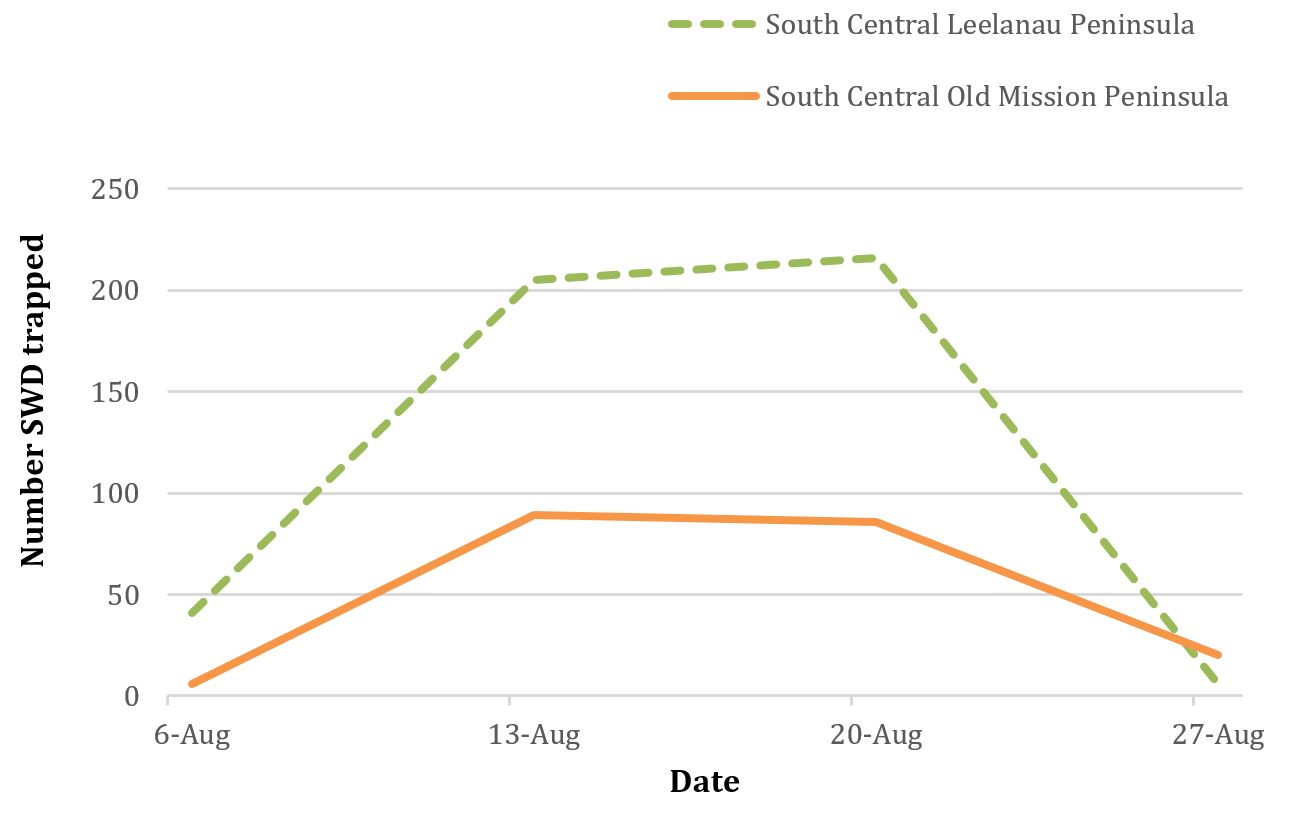Weather events lead to biotic pressures as grape harvest approaches
Understanding how heavy rain and wind can damage fruit and lead to increased biotic pressure is the first step in controlling fungal and insect damage that may follow.

Abiotic events of the 2018 growing season
From May 1 through Aug. 20, 2018, most grape producers in Michigan’s northwest region (Leelanau and Old Mission American Viticulture Areas, AVAs) would describe this growing season as relatively warm and dry compared to the past five years (Figs. 1-2, Table 1). However, on the evening of Aug. 28, a severe storm system with high winds and heavy rains dropped a considerable amount of rain on Leelanau and Old Mission Peninsula AVAs, and the majority of the state as well.
Figure 2. Growing degree-days (GDD) and rainfall in the Leelanau AVA.
|
Table 1. Rainfall comparison over the last five years for the Leelanau AVA. | ||
|---|---|---|
|
Year |
April 1 – Sept. 5 | |
|
Rainfall total (inch) |
GDD (base 50) | |
|
2018 |
14.07 |
2,319 |
|
2017 |
13.89 |
1,874 |
|
2016 |
10.37 |
2,245 |
|
2015 |
10.52 |
1,946 |
|
2014 |
16.9 |
1,778 |
|
2013 |
13.21 |
1,940 |
|
Average of 5 years |
12.98 |
1,956 |
From the west, the damaging rain and wind resulted in cluster damage, as berries on most V. vinifera cultivars at that time had reached 75-100 veraison (coloring) and began to soften and become more vulnerable to contact damage. In fact, a severe case of cluster damage was observed on a V. vinifera ‘Siegerrebe’ grapevine located on the western-most row in Leelanau County that had its berries ripped from the rachis by the powerful rain and winds of the storm system on Aug. 28 (Photos 1-6).
Obviously this unpredictable, late-season weather cannot be controlled, but understanding how heavy rain and wind can damage fruit and lead to increased biotic pressure is the first step in controlling the significant fungal and insect damage that may follow.
.jpg)
Photo 1. Aug. 27, 2018. Siegerebbe pre-damage.
.jpg)
Photo 2. Aug. 27, 2018. Siegerebbe pre-cluster damage.
.jpg)
Photo 3. Aug. 27, 2018. Siegerebbe pre-cluster damage.
.jpg)
Photo 4. Aug. 31, 2018. Post-damage.
.jpg)
Photo 5. Aug. 31, 2018. Post-damage.
.jpg)
Photo 6. Aug. 31, 2018. Post-damage.
Biotic pressure as it relates to fruit quality
The initial berry damage has been relatively widespread with reports of highest damage located on the western most rows, which received the brunt of the wind, in north-south oriented vineyard rows. This initial berry damage on Aug. 22, along with the largest and most rapid increase of precipitation of the entire growing season where over 5 inches of rain fell in the span of only six days (Aug. 22-28 in Fig. 2), has led to other more troublesome issues in the vineyard with the proliferation of fruit rots (fungus) and increased wasp pressure reported at some sites.
This means grape producers of this region should scout their vineyards for fruit rots and wasp activity, starting with the western most sections of vineyard blocks, as they most likely received the highest amount of damage. If concerning wasp activity is observed, install traps along the outside border of the vineyard and wood line.
In fact, there is a recent report of significant wasp activity determined by monitoring wasp traps in a Pinot gris block. In this block alone and in the time span of only 24 hours, an average of 20 wasps were trapped. If left unchecked, fruit rots and wasp damage can decimate the crop amount and severely reduce the fruit quality.
Fortunately, not all insects appear to be capitalizing on the current status of the region’s vineyards. The numbers of spotted winged Drosophila (SWD) trapped have decreased significantly during the same time period as the heavy rains (Fig. 3). This indicates these recent rainy conditions have decreased this invasive pest’s activity in vineyards.
Figure 3. Number of SWD trapped at vineyard borders in Leelanau and Old Mission Peninsulas.
Although SWD is not a severe threat to most grapevine cultivars, it is important to continue monitoring vineyard blocks that appear susceptible such as thin-skinned cultivars like V. vinifera ‘Pinot noir’ as fruit maturation continues through September and October.
There is widespread information on in-vineyard wasp and fruit rot control, and the following resources can be a starting point:
- Harvest Pests of Grapes, University of Kentucky
- Understanding and Controlling Botrytis, Practical Winery & Vineyard Journal



 Print
Print Email
Email and rainfall in the Leelanau AVA.JPG)






